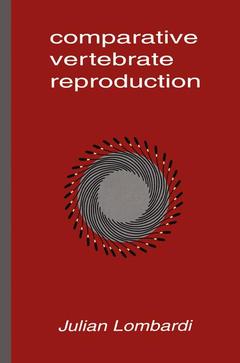Description
Comparative Vertebrate Reproduction, 1998
Author: Lombardi Julian
Language: English
Subjects for Comparative Vertebrate Reproduction:
Keywords
biology; ecology; physiology; reproduction; reproductive biology; vertebrates; zoology
Approximative price 210.99 €
In Print (Delivery period: 15 days).
Add to cart
Publication date: 10-2012
469 p. · 15.5x23.5 cm · Paperback
469 p. · 15.5x23.5 cm · Paperback
Description
/li>Contents
/li>Comment
/li>
Comparative Vertebrate Reproduction is the only comprehensive textbook covering major topics in the reproductive biology of vertebrates, from sexuality and gametogenesis to reproductive ecology and life history tactics. The work draws heavily on recent reviews and papers while placing topics in a historical context and conceptual framework. In addition, the author provides detailed comparative surveys of each of the major topics discussed.
Comparative Vertebrate Reproduction has been written as a textbook for upper-level undergraduate and graduate-level students in biology, zoology, physiology, animal science, and veterinary medicine. The work also serves as an excellent reference for researchers in medical and veterinary schools working in reproductive medicine.
Comparative Vertebrate Reproduction has been written as a textbook for upper-level undergraduate and graduate-level students in biology, zoology, physiology, animal science, and veterinary medicine. The work also serves as an excellent reference for researchers in medical and veterinary schools working in reproductive medicine.
Preface. 1. Introduction to Vertebrate Reproductive Biology. 2. Sex and Sexual Differentiation. 3. Modes of Reproduction. 4. Urogenital Structure and Integration. 5. Gametes and Their Production. 6. Reproductive Regulation. 7. Fertilization and Cleavage. 8. Embryogenesis. 9. Ovuliparity and Modes of Embryo Retention. 10. Embryonic Nutrition and Placentation. 11. Postpartum Care of Young. 12. Life Histories. 13. Mating Systems and Reproductive Ecology. References. Index.
'... the chapters are generally authoritative, providing useful overviews of a variety of research topics in vertebrate reproduction. The book is first rate: very broad, readable (including extra explanations provided in many useful footnotes), well illustrated with many useful figures and tables, organized, thorough, clearly written and truly integrative in its coverage of the biology of comparative reproduction. It will work well as a text and as a valuable reference for professionals from a multitude of disciplines.'American Scientist, September/October 1999
© 2024 LAVOISIER S.A.S.
These books may interest you

Vertebrate Endocrinology 132.33 €



